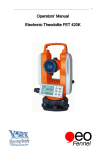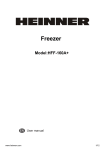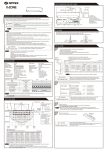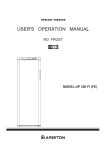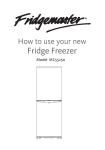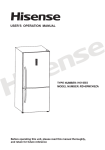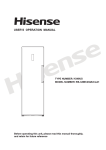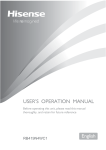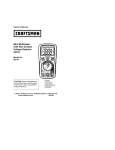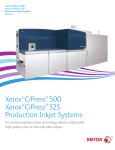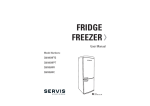Download Elba EUF-2217S Owner`s manual
Transcript
Owner’s Manual Please read this manual carefully before opetating your set. Retain it for future reference. Record model number and serial number of the set. See the labei attached on the back cover and quote this information to your dealer when you require service. For The Warranty Terms & Conditions, Please Refer To Warranty Certificate. Operating Instructions Dear customer, To enable you to use your new freezer effectively and safely, please read this instruction book carefully before you start the appliance, which contains important information for installation, safe use and maintenance of this appliance. Please keep the book for future reference and remember to pass it on to the new owner. The following symbol will be found in the book to guide you through the instruction: Guide to use the instruction book Warnings Operating instructions Tips and notes Warnings are stressed with a warning triangle or with signal words (Warning!, Important!), which are provided in the interest of your safety. Ensure that you understand them all before installing and using this appliance. Tips and notes will inform you with necessary knowledge of how to use the appliance economically and environmentally. Operating instructions presented in the section of “Trouble shooting” contain instructions for correction of possible malfunctions by users. If these instructions are not sufficient, contact your supplier. 1 INDEX Important safety instructions .....................................3 Installation Instructions ............................................ 5 Description of the Appliance .....................................6 Using Your Appliance ............................................7 Thermostat Control .. ........................................... 8 Hints and Tips ................................................... 10 Troubleshooting .................................................12 Reversing the door ...............................................14 2 Important safety instructions These warnings are provided in the interests of your safety. Ensure that you understand them all before installing or using this appliance.Your safety is of paramount importance. If you are unsure about the meanings of these warnings, contact the Customer Care Department for assistance. Intended to use The refrigerator is intended for use in the home.It is suitable for the storage of food at low temperature. If the appliance is used for purposes other than those intended or used incorrectly, no liability can be accepted by the manufacturer for any damage that may be caused. Alterations or changes to the freezer are not permitted for reasons of safety. If you use the freezer in a commercial application or for purposes other than the cooling of foods, the manufacturer accepts no liability for any damages that may occur. Prior to initial start-up Check the appliance for transport damage.Under no circumstances should a damaged appliance be plugged in. In the event of damage, please contact your supplier. Refrigerant The refrigerant isobutene (R600a) is contained within the refrigerant circuit of the appliance,a natural gas with a high level of environmental compatibility, which is nevertheless flammable. During transportation and installation of the appliance, ensure that none of the components of the refrigerant circuit becomes damaged. The refrigerant (R600a) is flammable. Caution: risk of fire If the refrigerant circuit should become damaged: Avoid open flames and sources of ignition. Thoroughly ventilate the room in which the appliance is situated. The instructions shall include the warnings: WARNING!—Keep ventilation openings, in the appliance enclosure or in the built-in structure,clear of obstruction. WARNING!—Do not use mechanical devices or other means to accelerate the defrosting process, other than those recommended by the manufacturer. WARNING!—Do not damage the freezer circuit. WARNING!—Do not use electrical appliances inside the food storage compartments of the recommended by the manufacturer. 3 WARNING!—This appliance is not intended for use by persons (including children) with reduced physical, sensory or mental capabilities, or lack of experience and knowledge, unless they have been given supervision or instruction concerning use of the appliance by a person responsible for their safety WARNING!—Young children should be supervised to ensure that they do not play with the appliance WARNING!—If the supply cord is damaged, it must be replaced by the manufacturer, its service agent or similarly qualified persons in order to avoid a hazard. WARNING!—The appliance is only applied with power supply of single phase alternating current of 220~240V/50Hz.If fluctuation of voltage in the district of user is so large that the voltage exceeds the above scope, for safety sake, be sure to apply A.C.The appliance must employ a special power socket instead of common one with other electric appliances. Its plug must match the socket with ground wire. Safety for children Packaging (e.g. wraps, polystyrene) can be dangerous for children. There is a risk of suffocation! Keep packaging material away from children! Make old appliances unusable prior to disposal.Pull out the mains plug, cut off the mains cable, break or remove spring or bolt catches, if fitted. By doing this you ensure that children cannot lock themselves in the appliance when playing (there is risk of suffocation!) or get themselves into other dangerous situations. Often children cannot recognize the hazards present in household appliances. It is therefore important that you ensure adequate supervision and never let children play with the appliance! Daily operation Containers with flammable gases or liquids can leak at low temperatures.There is a risk of an explosion! Do not store any containers with flammable materials such as spray cans,fire extinguisher refill cartridges etc in the refrigerator and/or freezer. Do not operate any electrical appliances in the refrigerator and/or freezer (e.g. electric ice cream makers, mixers etc.). Before cleaning the appliance,always switch off the appliance and unplug it,or pull the house fuse or switch off the circuit breaker. When unplugging always pull the plug from the mains socket, do not pull on the cable. In case of malfunction If a malfunction occurs on the appliance,please look first in the “Troubleshooting”section of these instructions.If the information given there does not help, please do not perform any further repairs yourself. 4 Under no circumstance should you attempt to repair the appliance yourself.Repairs carried out by inexperienced persons may cause injury or serious malfunctioning.Contact your local service center. Remove transport packaging The appliance and the interior fittings are protected for transportation. Pull off the adhesive tape on the left and right side of the door. You can remove any remnants of adhesive using white spirit. Remove all adhesive tape and packing pieces from the interior of the appliance. Installation Instructions Installation Location Before installing, carefully read the instruction in order to avoid a certain number of problems. Positioning Position the appliance away from sources of heat such as stoves, radiators, direct sunlight etc. Maximum performance and safety are guaranteed by maintaining the correct indoor temperature for the class of unit concerned, as specified on the rating plate. The appliance may not work properly if it is left for a longer period at a temperature above or below the indicated range. IMPORTANT! -There is a need of good ventilation around the fridge for easy dissipation of heat, high efficiency of freezer and low power consumption. For this purpose, sufficient clear space should be available around the freezer. It is advisable for there to be 75mm separating the back of the freezer to the wall, at least 100mm of space at its two sides, height of over 100mm from its top and a clear space upfront to allow the doors to open 160°. Climate class Ambient temperature SN +10 C to+32 C N +16 C to+32 C ST +16 C to+38 C T +16 C to+43 C Appliances must not be exposed to rain. Sufficient air must be allowed to circulate in the lower rear section of appliances, as poor air circulation can affect performance. Built-in appliances should be positioned away from heat sources such as heaters and direct sunlight. Leveling The appliance should be level in order to eliminate rocking. To make the appliance level, it should 5 be upright and both adjusters should be firmly contacted with the floor. You can also adjust the level by screwing out the appropriate level adjuster at the front (use your fingers or a suitable spanner), but much care should be taken when moving this appliance since it should be heavy. The supply cord Care must be taken to ensure that the appliance does not stand on the electrical supply cable. if the supply cord is damaged, it must be replaced by a special cord or assembly available from the manufacturer or its service agent. Description of the Appliance View of the appliance 1. Control panel 1 2. Flap 7 3. Drawers 4. Ice tray (inside) 2 5. Lower drawer 6. Caster 7. Door 3 4 5 6 Note: Due to unceasing modification of our products your refrigerator may be slightly different from this Instruction Manual, but its functions and using methods remain the same. IMPORTANT! – in order to make the most of the volume of the fresh food storage compartment and frozen-food storage compartment, the user can removed one or more shelves, drawers, out of the appliance, according to your daily use. Freezer chamber It is for freezing and storing frozen foods and making ice cream, etc. 6 Ice tray It is for making ice, pour cool boiled water into ice tray up to 4/5 of its volume, place it in freezer room for 2 hours and the ice can be made automatically. When you want to take ice tubes, please twist the ice tray slightly, and the ice tubes are separated form the ice tray. But do not bend it, otherwise it will crack. Notes: Technical information Because it takes a long time to make ice tubes, you can not hold the ice tray directly when take out the ice cubes to avoid the ice tray sticking and hurting your hands. Drawers in freezer It is for freezing or storing foods. You must cut the big meat into small pieces to avoid hard cutting when cook. The quick-freeze foods must be evenly placed in drawer, and put them together to store after freezing. Using Your Appliance This appliance is designed for domestic use only, specifically for the storage of edible foods. And it is designed to operate in ambient temperatures (surrounding air temperature) between 16℃and 38℃.If the temperature exceeds that designed, either colder or warmer, the appliance will not work effectively and correctly. Should the ambient temperature be exceeded for long period, the temperature in the freezer will rise above -18℃and food spoilage may occur. Before use Remove all securing tapes. Wash the inside of the appliance with lukewarm water added with a little bicarbonate of soda (5ml to 0.5 liter of water). Do not use soap or detergent since the smell may linger. After cleaning, dry the appliance thoroughly. To start the appliance Operating instructions 1.Allow the appliance to stand for 2 hours after installation. 2.Plug in the appliance and turn on the power. 3.Turn the thermostat control to the required setting. A midway setting is usually suitable for normal operation. 4.Leave the appliance for approximately 4 hours to reach the correct temperature before placing food inside. 7 Thermostat control The thermostat control situated in the control panel regulates the temperature of the freezer compartment. Position“MIN”–Cold. Position“NORMAL”–Colder normally, setting at this position. Position“MAX”–Coldest. Normal Min Max The temperature will be affected by: Room temperature How often the door is opened How much food is stored Position of the appliance In determining the correct temperature control setting, all these factors have to be considered and some experimentation may be necessary. Do not allow children to tamper with the controls or play with the product. Important! Normally we advise you select setting of “Normal”, if you want the temperature warmer or colder please turn the knob to lower or higher setting accordingly. When you turn the knob to a colder setting which can lead to the more energy efficiency. Otherwise, it would result the energy-consuming. Important! High ambient temperatures (e.g. on hot summer days) and a cold setting on the temperature regulator (position “MAX”) can cause the compressor to run continuously or even non-stop. Reason:when the ambient temperature is high,the compressor must run continuously to maintain the low temperature in the appliance. The freezer compartment The symbol means that your freezer will store frozen food at -18 ℃(-4F) or colder allow- ing for long term frozen-food storage and freezing of fresh food. The freezer temperature is controlled automatically by the thermostat situated in the control panel. Due to the different installations, methods of usage and weather conditions, adjustments to the temperature settings may be required. These are best assessed against a temperature reading on a thermometer buried in the frozen food. The reading must be taken quickly as the thermometer temperature will rise rapidly after removal. 8 Freezing fresh food Place the fresh food in the top freezer drawer. Food may need rearranging to achieve this. During the freezing process the temperature of fresh food should be reduced quickly so that ice crystals are kept as small as possible to avoid damaging the structure of food. If freezing takes place slowly large ice crystals form and these will affect the quality of food once it has defrosted.Existing frozen food should be rearranged to leave space in the top two drawers for freezing. The packets to be frozen should be placed in the drawer in contact with the drawer surface as far as possible and spaced apart to allow cold air to circulate between them. They should not touch existing packets. If there is enough room, transfer the food you have frozen to the baskets or drawers to allow you to freeze a further load in the top drawer. Exceptionally large items can be stored by removing the drawer. Frozen food should not be refrozen once it has thawed out. Do not remove items from the freezer if your hands are damp/wet, as this could cause skin abrasions or “frost/freezer burns”. For safety reasons, the freezer drawer are fitted with stops but are readily removed by pulling them forward to the stop, then lifting the front and pulling all the way out. Refit by reversing this procedure. Frozen food storage Pre-packed commercially frozen food should be stored in accordance with the manufacturer's instructions for a 4 star frozen food compartment and should be put in the freezer as soon as possible after purchase. Your freezer provides for long term storage which generally means up to 3 months but the length of the time can vary and it is important to follow the recommended times shown on packets of commercially frozen food. Do not place sealed containers or carbonated liquids such as fizzy drinks into the freezer as it creates pressure on the container which may cause it to explode leading to damage to the freezer. Ice cubes and ice lollies should not be consumed immediately after removal from the freezer as it may result in low temperature skin abrasions. 9 Hints and Tips Food storage To use your appliance more effectively, evaporator should be placed in the larder compartment. Avoid buying frozen food if you cannot store it. Store in original container is advisable. Please place the frozen foods you bought into the freezer as soon as you arrive home, and make sure: Do not push food together too much. Try to allow air to circulate around each item. Do not store food uncovered. Ensure the foods placed in the freezer are dated and labeled, and used them in date order, so you can consume them at its best. Remember to remove suspect food from your freezer and keep it cleaning inside. Energy Saving tips 1. Do not place warm foods into the appliance. Allow warm foods to cool first. Do not install the appliance near cookers, radiators or other sources of warmth. High ambient temperatures cause longer, more frequent operation of the compressor. 2. In order to make the cooling system work efficiently, please make sure the side plates and back plate of the product are with some distance from the wall. It is strongly recommended that its back is 75mm away from the wall, its sides at least have a space of 100mm separately and the height from over its top is not less than 100mm. 3. When the product works, please do not open the door too often or leave the door open any longer than necessary. 4. Do not set temperature any colder than necessary. 5. The direct cooling refrigerator (with a freezer) needs to be defrosted when necessary. This will improve the cold transfer and reduce energy consumption. 6. The sketch map shows the right combination of the drawers, crisper and shelves which can lead to the more energy efficiency. If users adjust the combination, it would result in the energyconsuming. 7. Store food logically. Do not exceed the storage period specified. In the event of a power failure If there is a power failure when the appliance works, don't open the door. If the temperature inside your freezer should rise, do not refreeze the food without checking its state. The following guidelines will assist you: 10 Ice cream once thawed should be discarded. Bread and cakes: Can be refrozen without danger. Shellfish: Should be refrigerated and used up quickly. Cooked dishes: i.e. casserole should be refrigerated and used up. Large pieces of meat: Can be refrozen if there are ice crystals remaining within them. Small joints: Should be cooked and then refrozen as cooked dishes. Chicken: Should be cooked and refrozen as a fresh dish. Defrosting Why defrosting Water contained in food or getting into air inside the fridge be opening doors may form a layer of frost inside. It will weaken the refrigeration when the frost is thick. While it is more than 10mm thick, you should defrost. Defrosting in frozen-food storage compartment To defrost the freezer 1.Wrap any food in blankets and keep them in a cool place. 2.Switch the appliance off at the wall socket and remove the plug. 3.Open the freezer door. 4.Place a suitable container to collect the water from the thawing frost. 5.After defrosting, clean and dry the interior. 6.Switch the appliance on and replace any frozen food. Defrosting can be speeded up by putting bowls of hot (not boiling) water in the freezer and loosening the frost with a suitable plastic scraper. If the temperature of frozen food is allowed to rise during defrosting, its storage life may be shortened. Important! The fridge should be defrosted at least every one month. During the using process, if the door was opened frequently or using the appliance in the extreme humidity, we advise the user to defrost every two weeks. 11 Troubleshooting Noises during Operation The following noises are normal characteristics of the appliance when it works: Whenever the compressor switches on or off, a click can be heard. As soon as the compressor is in operation, you can hear it humming. When refrigerant flows into thin tubes, you can hear bubbling or splashing noises. Even after the compressor has been switched off, the noise of splashing can be heard for a short time. Repairs to the freezer may only be conducted by competent service engineers. Improper repairs can lead to significant hazards for users. If your appliance needs repairing, please contact your specialist dealer or your local service center. PROBLEM The freezer does not operate The freezer is too warm SOLUTION Check that it is properly plugged in, that the fuse has not blown or that the circuit-breaker has not tripped. Check the thermostat and make sure that the door stays open as little as possible. Also check that the door closes properly. Make sure that the freezer is well ventilated, leaving gaps as mentioned in the “Installation” chapter. Also check that your The motor runs continuously appliance is not exposed to a direct source of heat. You may also have placed too much food inside or the door may not close properly. 12 A malfunction may be caused by only a minor fault that you can rectify yourself using the following instructions.Do not perform any other work on the appliance if the following information does not provide assistance in your specific case. Important! Repairs to refrigerators/freezers may only be performed by competent service engineers.Improper repairs can give rise to significant hazards for the user. If your appliance needs repairing, please contact your specialist dealer or your local service center. Regulations, Standards, Guidelines This appliance is in accordance with the following EU guidelines: -73/23/EEC low voltage guidelines. -89/336/EEC EMC Directive -2009/125/EC framework for the settting of ecodesign requirements for energy-using -EC.643/2009. requirements for household refrigerating appliances. Disposal of the appliance It is prohibited to dispose of this appliance in domestic household waste. For disposal there are several possibilities: 1. The municipality has established collection systems ,where electronic waste can be disposed of at least free of charge to the user. 2. The manufacturer will take back the old appliance for disposal at least free of charge to the user. 3. As old products contain valuable resources ,they can be sold to scrap metal dealers. Wild disposal of waste in forests and landscapes endangers your health when hazardous substances leak into the ground-water and find their way into the food chain. Correct Disposal of this product This marking indicates that this product should not be disposed with other household wastes throughout the EU. To prevent possible harm to the environment or human health from uncontrolled waste disposal, recycle it responsibly to promote the sustainable reuse of material resources. To return your used device, please use the return and collection systems or contact the retailer where the product was purchased. They can take this product for environmental safe recycling. 13 Reversing the door The side at which the door opens can be changed from the right side (as supplied) to the left side, if the installation site requires. Before you start lay the refrigerator on it's back in order to gain access to the base,you should rest it on soft foam packaging or similar material to avoid damaging the cooling pipes at the rear of the refrigerator. 1.Stand the refrigerator, use a flat bladed screw driver to remove the 4 screw covers at the rear of the refrigerator lid. 2. Unscrew and lift the lid from the rear and remove it, then lift the upper door and place it on a padded surface to prevent it scratched. 3. use a flat bladed screw driver to remove the front ornament of top cover plate. 4.Replace the front ornament of top cover plate in the other side 14 5.Remove the upper hinge core,transfer it to left side and tighten securely,then put it in a safe place 6.Remove both adjustable feet and remove the bottom hinge bracket by unscrewing the bolts. 7. Unscrew and remove the bottom hinge pin, turn the bracket over and replace it. Refit the bracket fitting the bottom hinge pin. Replace both adjustable feet. Transfer the lower door to the property position. Secure the door's level, make the bottom hinge pin into the lower hole of the door, then tight the bolts. 8.Replace the lid by fitting the upper hinge core into the upper door's hole, securing it with the 4 screws. Replace the screw covers. Warning! When changing the side at which the door opens, the appliance must not be connected to the mains. Remove plug from the mains beforehand. 15 When you reverse the door ,please do this first : Move the accessory B from the upper cover of upper door and fit the accessory A that is a small detachable part from a small bag. 16

















